Cranes for heating radiators: how to choose the necessary
For the correct functioning of the heating system, it is necessary to precisely regulate the volume of coolant that enters the battery and remove the accumulated air from it. In addition, sometimes - in the event of an accident or the need for a planned replacement - it is necessary to completely block the access of fluid to the heating panel. In all the cases listed above, the tap on the heating radiator will help out, with the help of which you will be able to switch off various parts of the climate network with your own hands without completely stopping the operation of the latter and discharging the batteries.
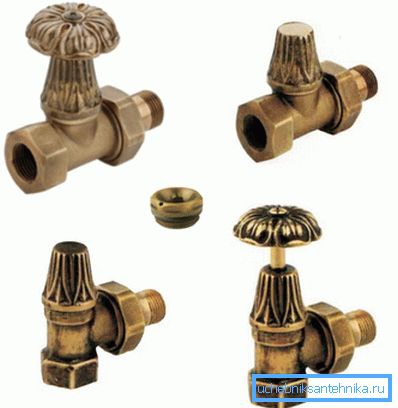
Water taps
Purpose of equipment
Cranes that are mounted on radiators are necessary not only to block access of water to the equipment.
They perform many other equally important tasks:
- regulate the temperature of the radiator by limiting the amount of hot water pumped through the battery;
- remove air plugs from the heating system, which greatly reduce the effectiveness of its work;
- They are used to fill and discharge coolant not only in radiators, but also in pipelines connecting them;
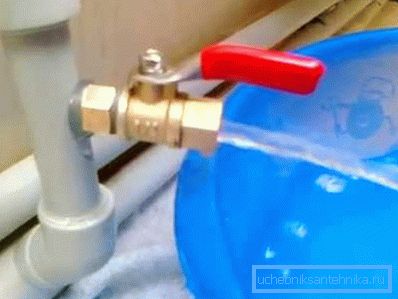
- can be used to shut off the heating network in case of an accident, planned or emergency repairs.
Based on the above tasks, it is necessary to distinguish the following types of cranes:
- To disconnect the main pipeline, part of the heating network or a separate device. With their help, you can turn off the water in case of an accident or repair.
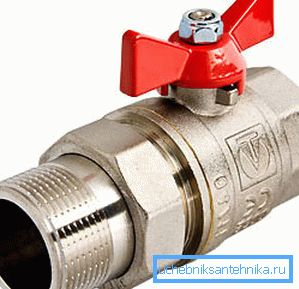
- To adjust the flow of water. In this case, in addition to the “on” and “off” modes, there must be others. The ability to set the temperature in the house depends on how accurately the valve can set the amount of coolant supplied.
- To discharge gas or water. In the first case, the valves help to get rid of air closures, in the second - to remove fluid from pipes and radiators, after which you can inspect and replace them.

Installation sites
Despite the name, a valve for a heating radiator can be mounted not only on the specified equipment, but also in other places (depending on the functional purpose):
- at the entrance of the central heating main to the basement of the house - they open and close at the beginning and at the end of the heating season;
- to the bypass (pipe between the inlet and outlet of the battery that provides direct flow of the coolant) - here regulating valves are needed to reduce or increase the volume of flowing fluid and switch the forced network to natural circulation;
- on risers - often such cranes are mounted at the entrances to an apartment in high-rise buildings and allow repair of the local climate network without shutting down the entire system;
- on the battery nozzles - their main purpose is to adjust the air temperature, because automatic thermostatic valves are appropriate here;
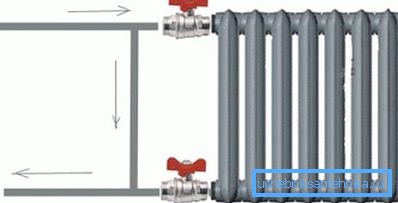
- in places where an air blockage may form - here are installed Mayevsky's taps, which serve to release air that accumulates when the system is filled with coolant or during its operation.
Note! The use of valves, adjustable automatic, allows without human intervention to dispense the amount of water entering the battery and remove the accumulated air from the system. The disadvantage of such solutions is only one - the high price.
Materials used
A feature of the shut-off and control valves installed in heating systems is its constant contact with the coolant, the chemical and physical composition of which often leaves much to be desired.
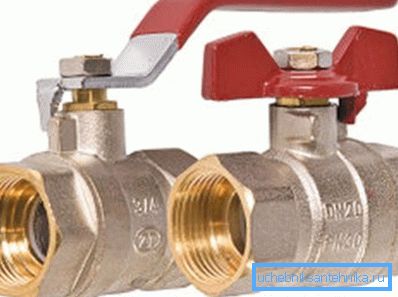
Therefore, the material used in them must be resistant to corrosion and withstand well the mechanical action of abrasive particles that are found in the circulating fluid.
The most commonly used cranes are made of the following materials:
- brass –– fixed to pipelines with special fittings;
- polypropylene - is installed on polymer pipes by soldering.
Tip! In some hardware stores you can find silumin cranes. They look like brass, but they cost much less. Their quality, strength and durability is low, so you should not use such valves for the design of engineering networks.

Crane Types
All existing cranes are divided into two groups:
- Shut-off. There are straight and angular. They are mounted on radiators and used to block access and regulate the amount of hot water entering the batteries. Their use allows you to protect the heating panel from the hydraulic and pneumatic impact that occurs during the filling of the system with coolant. In addition, they provide an opportunity to turn off a particular battery and repair it, clean it or replace it. They are easily mounted on batteries using pipe threads, forming a completely tight connection. Well withstand strong fluid pressure and have an attractive appearance.

The disadvantage is the impossibility of fine temperature control in the room. Often used in autonomous heating systems, where mode switching is carried out using the boiler control panel.
- Thermostatically controlled. Inside the crane is a special flexible container filled with liquid or gas. When heated or cooled, it, respectively, increases or decreases, regulating the access of water to the battery and, thus, temperature. There are two types of thermostatic cranes:
- with manual control - in this case, you turn the knob and set the temperature yourself, focusing on the numbers that are applied to the body of the crane;
- automatic - in this case, the temperature in the room is controlled by a microchip depending on the external conditions (the data provided by special sensors are used).

The advantages of the latest type of cranes are obvious:
- the ability to change the temperature of the battery, depending on weather conditions;
- saving of heat carrier due to more fine adjustment of the operation of the climatic equipment;
- protection against freezing of the coolant with a sharp decrease in the external temperature.
Classification of locking mechanisms
Heating taps are classified according to one more feature - the design of the locking device.
They are:
- ball (flange) - can only be in the on and off state, intermediate options are not provided;

- conical - allow you to close the hole for the flow of water, open it and put the valve in intermediate positions;
- automatic - control of the volume of the flowing fluid is regulated with the help of special electronics.
Flanged taps are most often installed on pipelines. This is because their design is able to withstand high fluid pressure. They can reliably serve for a long time.
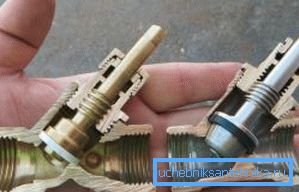
As for the radiators themselves, they use conical products equipped with couplings. The presence of the thread allows you to tightly fix the control valves to the inlet and outlet of the battery, and the conical locking mechanism allows you to more accurately adjust the amount of incoming water.
Mayevsky's crane
In addition to water taps, air batteries are mounted on radiators. They are called Mayevsky cranes. They serve to remove air that inevitably forms in pipes and radiators during operation of the system. The installation instructions for heating systems provide for the installation of such devices in the upper part of each heating panel.
Operating principle
The main element of the crane Mayevsky serves as a needle air valve. This mechanism can be activated by a special key or a conventional screwdriver.
The air valve must be installed on the side opposite to the intake valve of the radiator. As the heat carrier is filled, the air present in the battery rises up and accumulates in the far upper corner of the device. There is installed a crane through which the formed air blockage is released.

The procedure for working with the Mayevsky valve is simple: you need to unscrew the screw until a hissing sound that emits outgoing air appears. As soon as water emerges from the hole, the valve can be closed.
The crane can have a polymeric body or be made of brass. Both of these options are quite reliable. It is only necessary to ensure that the outlet of the air valve is not clogged with solid particles, which are sometimes found in the coolant. You can clean it with an ordinary needle.
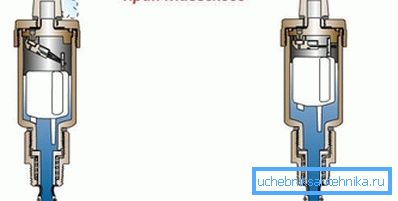
Tip! If you have a heating system with forced circulation in your home, you must turn off the pumping equipment before removing the airlock using a Mayevsky crane. Otherwise, hot water will flow too quickly and air will not have time to accumulate in the upper part of the radiator.
Automatic Air Valves
Each manufacturer of sanitary equipment strives to produce equipment that regulates certain parameters of the engineering networks without human intervention. This also applies to air valves that remove plugs from batteries and heating pipes.
Automatic crane Mayevsky looks practically no different from its progenitor. The principle of its functioning has also not changed. However, a special mechanism independently opens the valve when the pressure of the air in the battery increases above the set value.

Thus, the installed automatic air valve will relieve you of the need to periodically check the heating system to detect air jams and eliminate them manually.
Features of the installation of automatic cranes Mayevsky
This device can be mounted on almost all existing radiators. However, owners of widespread cast iron batteries will have to be disappointed. Mayevsky's crane will not help them to cope with the air in the climate network.
This is affected by the following circumstances:
- The internal surfaces of the cast-iron radiator gradually become rusty during operation, the particles of which come off, get into the coolant and may clog the bypass opening of the automatic air valve.
- The central water supply system, of which the cast-iron batteries are part, is not equipped with filters that trap solid particles in the heat transfer fluid. In addition, various aggressive chemicals are often added to the water, which also adversely affect the operation of the air valves.
- Of the radiators connected to the urban heating system, often in the summer period they drain water. Therefore, after filling the system, too large plugs may form, which will not work out through a 2-mm hole. We'll have to use more effective methods.
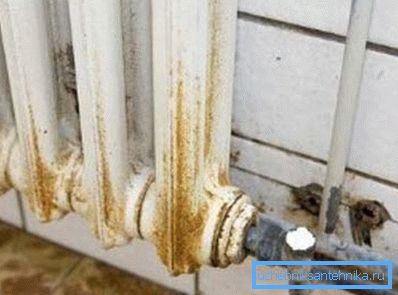
Note! All the advantages of automatic Mayevsky cranes are revealed only when designing autonomous control systems, where it is possible to control the quality of the coolant, its temperature, pressure, and other equally important operating parameters.
Conclusion
Shut-off and control valves for the organization of the circulation of water and air in the heating system plays a very important role. But besides it, a large number of other equipment is used in the design of heating networks. You can learn more visual features of our theme from the video below.